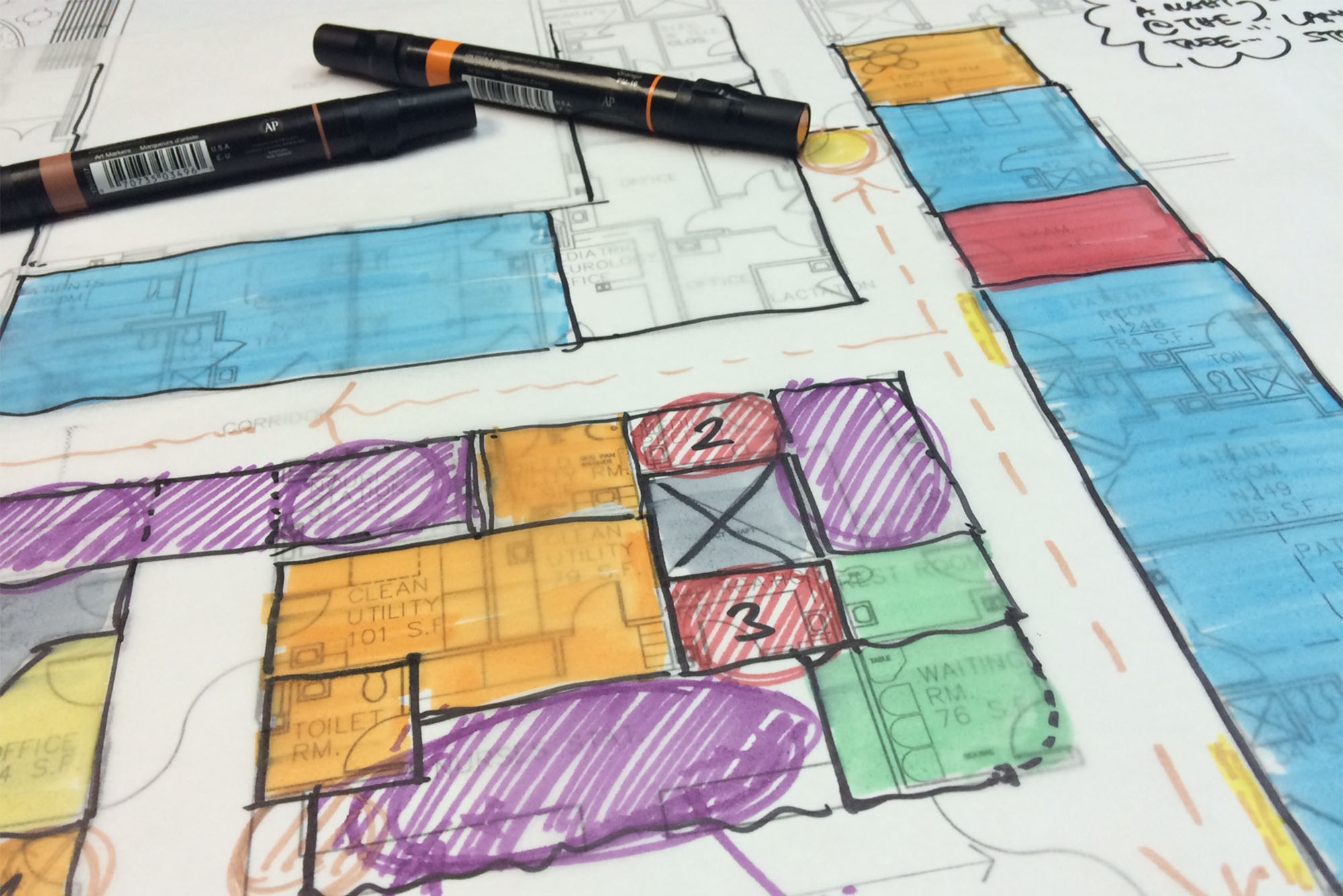How the Design of Hospitals Impacts Patient Treatment and Recovery

Diana C. Anderson, a BU expert on hospital design, says her patients and clinical work help inform her research and design solutions. Sketch courtesy of Anderson
How the Design of Hospitals Impacts Patient Treatment and Recovery
BU’s Diana C. Anderson is a “dochitect”—a medical doctor and an architect—who says everything in a hospital’s design, from the location of a room to the patterns on the floor, can shape how patients heal
If you’re going into hospital for treatment, you want the best: the finest doctors, the latest medicines, the most-advanced surgical techniques. But the success of your care could also come down to something much more mundane than medical or technical wizardry: the location of your room. Land in an out-of-sight intensive care room and your chances of bouncing back tumble versus getting placed opposite the nursing station—you might even be more likely to die. Other aspects of your hospital room’s design—the position of the bed, the location of the sink, whether there’s a window—may also shape your recovery.
Poor hospital architecture and design could be keeping you laid up, but it doesn’t have to be that way, says Diana C. Anderson, a Boston University geriatrician who is also an expert on hospital design. She studies healthcare facilities with the goal of raising awareness of the potential for the built space to influence care and recovery.

Anderson isn’t just a medical doctor and researcher with a side interest in hospital design. She’s a licensed architect who helps plan hospitals and clinics. In a paper for the independent bioethics think tank, the Hastings Center, Anderson has argued that healthcare architecture is so impactful it should be held to the same standard as medications and surgical procedures. Design, she and her coauthors wrote, can alter behavior, shape patient-clinician interactions, and sway treatment outcomes. A building’s ability to influence—or harm—us must, they argued, be disclosed.
“The built environment should be considered a medical intervention,” says Anderson, a BU Chobanian & Avedisian School of Medicine assistant professor of neurology. “We think a lot about the social determinants of health now: loneliness, isolation, socioeconomic status, diet. But the physical determinants of health—the built space around us, and our understanding of how that affects our health on an individual and public health level—is very poorly understood.”
That’s something Anderson is trying to change through her research, and her practice. She calls herself a “dochitect”—a combo that’s so rare, she trademarked the word. Last year, she was selected by the American College of Healthcare Architects to serve on its Council of Fellows; she’s also a healthcare architect at the global firm Jacobs.
In recent papers, Anderson has looked at the layout of intensive care units and residential care homes, studied the importance of design that fosters social connections, and examined the health effects of older adults’ access to transitional spaces—like windows, yards, and porches.
“As architects, we have a responsibility to do no harm through our designs,” she says. “What we’re building touches thousands of lives over many years. If data exists that suggests certain design techniques might be harmful, we have a responsibility to harness that research and utilize it in our building codes and guidelines.”
Understanding Good Design and Good Health
Doctor was never part of Anderson’s plan growing up in Montreal, Canada. She calls architecture “a sort of family business.” Her parents were both architects—they ran their own firm together and her dad led McGill University’s architecture school. But as an architecture student, Anderson started getting interested in the design of healthcare facilities. As part of her studies, she took a trip to a renowned tuberculosis clinic turned rehabilitation center in Finland, the Paimio Sanatorium.
“It was a wonderful place—I’d expected a horrible smell and dismal atmosphere,” says Anderson, who instead walked into a building surrounded by trees and suffused with light. “I wanted to understand the research behind that: Why did I have that [positive] reaction? What about the space triggered that response?”
As she toured more healthcare centers, she became fascinated not just by their design, but by the work happening in them.
“It spawned an idea to go and do medicine, partly because I also felt I wanted more contact with people than architecture could bring me. I made the shift over to medical studies, but I could never take off that design hat.”
Like when she took on a residency in a New York City hospital and found many patient beds were in the wrong place.
Architects have the best of intentions when designing spaces, but if they don’t have the clinical knowledge…issues are going to come up.
“I was trained in medical school to always examine a patient from the right-hand side as medical convention, but I would walk into a patient room in New York and the clinical exam table would be pushed up against the wall, so it took me longer to do the exam,” she says. “That’s what the dochitect idea is supposed to bridge: architects have the best of intentions when designing spaces, but if they don’t have the clinical knowledge, those issues are going to come up.”
Do No Harm
Next time you’re in a hospital, look down. Are there stripes on the floor? The direction of those lines might seem innocuous, but could have a big influence on the mobility of some people with dementia.
During a clinical fellowship at a San Francisco geriatric facility, Anderson says she and her colleagues found many patients would spend too much time in their rooms. They weren’t getting out and walking, which would slow their recovery: “One day of strict bed rest as an older adult, it’ll take you a week to get that deconditioning reversed—we want people to move.”
One possible reason they were so sedentary, says Anderson: the stripes on the floor all went in the wrong direction.
“If you paint stripes on the floor in front of an exit door, people with certain types of dementias and cognitive impairments will not approach it,” says Anderson, who published a paper in 2022 on the topic and last year completed a review of 20 years of research on long-term residential care environments for Health Environments Research & Design. “If you turn those stripes 90 degrees, people will go out the door.” Among other findings she highlighted in that latest paper: how kitchen-dining areas promote social interaction, outdoor gardens reduce depression, and higher ambient temperatures increase agitation among people with dementia.
“It’s an example of how we might be able to utilize certain design techniques that may cause less harm than others,” says Anderson. She’s the cofounder of a health design lab at Mass General Brigham, which is pursuing funding and conducting a pilot study on how to use technology to reduce delirium in patients in intensive care unit rooms; previous research has shown windowless rooms are associated with an increased risk of acute confusion.
Designing Better Well-Being for Older Adults
Her scrutiny of the health benefits—and potential detriments—of design doesn’t just apply to hospitals and care homes. Anderson is heading an Alzheimer’s Association–funded project to review environmental design and health outcomes related to older adults living in their communities.
“Most older adults are not living in nursing homes, fancy dementia villages, or specialized memory care units; they are in the community, being cared for by their family and friends,” says Anderson, who just wrapped up a three-year fellowship with the Veterans Affairs Boston Healthcare System, where she studied cognitive neurology. One particular focus of the new multiyear project is transitional spaces, areas that bridge the inside and the outside. “Do these spaces have an importance for older adults in terms of their social health, their isolation, their loneliness, which we know is a huge risk factor for health issues?”
In a recent study published in the Journal of Aging and Environment, for example, Anderson looked at how the use of transitional spaces changed during the COVID-19 pandemic. She and her colleagues compared older adults’ use of these areas in Boston and Chieti, Italy, finding the Italians were more likely to use these spaces in community with others, while their American peers spent more time in them alone.
Anderson’s latest article, in the AMA Journal of Ethics, argues that designers have a moral obligation to foster social interactions through their work, so crucial is it to our well-being. “Designers of community policies, programs, structures, and spaces should be accountable for promoting social connection,” she and her coauthors write, “to help generate measurable health outcomes, such as longevity.”
Given her unusual dual careers, Anderson is often asked to mentor others interested in healthcare architecture; mostly, she says, new doctors who want to shape the design of the spaces they interact with every day. One question she gets a lot: How do you combine two demanding jobs—architect, doctor—into one?
“I could leave clinical medicine and still have that knowledge and bring that to architecture,” says Anderson, who splits her workweek between the two fields, seeing patients a couple of days a week. “But it’s really through the patient encounters where ideas come up for research studies, for design work. It’s the users of the space that will drive the change we need in health systems.”

Comments & Discussion
Boston University moderates comments to facilitate an informed, substantive, civil conversation. Abusive, profane, self-promotional, misleading, incoherent or off-topic comments will be rejected. Moderators are staffed during regular business hours (EST) and can only accept comments written in English. Statistics or facts must include a citation or a link to the citation.